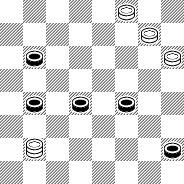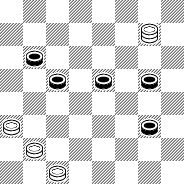The Checker Maven
Jump to navigationCrime Does Not Pay
A little while back we lamented the presence of computer-using cheaters on the major online play sites. We recently came across an article published over 80 years back in the Morris-Systems Checkerist magazine that highlights a similar problem, and how one cheater got what he had coming. We've reprinted the article below.

Falls Into Graceless Trap After Double Move
Not always, however, is it profitable for the sly-hander to make his moves unseen, and the man who thinks he is "getting away with it" will find now and then that he has dug a pit for himself too deep for escape.
We happened into a rather amusing demonstration of this not long ago while watching a player of good repute in a park exhibition where he was handling a number of boards simultaneously. As the exhibition player went from board to board we noticed that one of his opponents near us advanced a piece as if to test the position, then glanced up to see if he had been observed. When the exhibition player appeared at this board again the opponent made his regular move, but the piece he had advanced a minute before remained where he had placed it. The exhibitionist was plainly surprised. Evidently he had remembered the earlier position. We saw him eye his man with a keen glance, but said nothing, made his move and then went on to the next board.
Later, in the end game, the position on the board was as shown (below).

"Double Mover"--Black

White--Exhibition Player
White to Move and Win
Had the "double mover" been content with his first illegal move he might have gained a draw, but when he repeated his offense, he apparently aroused the wrath of the checker g-ds and brought himself to swift and sorry doom.
How did the Exhibition Player give the "Double Mover" his comeuppance? Solve the problem and click on Read More for the solution.
By moving from 21 to 17, which developed the following play: 14-21, 30-26, 21-30, 8-11, 30-23, 11-11, 9-14, 11-15, he was able to throttle him completely. Thus ended the game.
Editor's Note: How often do you see a quadruple circular jump such as 11-11 above? Spectacular!
You can email the Webmaster with comments on this article.
